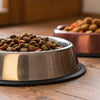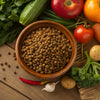How Much Dry Dog Food for a 100 lb Dog: A Comprehensive Feeding Guide
- Houndsy
Table of Contents
- Introduction
- Factors Affecting How Much to Feed Your Dog
- How Much Dry Dog Food for a 100 lb Dog?
- Portion Control and Feeding Frequency
- The Importance of Quality Ingredients
- The Houndsy Kibble Dispenser: Elevate Your Feeding Experience
- Conclusion
Introduction
Did you know that approximately 59% of dogs in the United States are considered overweight or obese? This alarming statistic highlights the importance of understanding how much dry dog food to feed our furry friends, especially for larger breeds. If you’re a proud owner of a 100 lb dog, the question of feeding can be both crucial and confusing. The right amount of food not only influences your dog's overall health but also impacts their energy levels, mood, and longevity.
Today, we’re diving deep into the intricacies of dog nutrition, specifically focusing on how much dry dog food is appropriate for a 100 lb dog. By the end of this post, you’ll have a clearer understanding of the factors that influence your dog’s dietary needs, practical feeding guidelines, and how to ensure your beloved pet stays healthy and happy.
We’ll explore various aspects, including the factors affecting feeding amounts, portion control, feeding frequency, and the importance of quality ingredients. We’ll also discuss how our flagship product, the Houndsy Kibble Dispenser, can transform your dog feeding routine into a seamless and stylish experience.
Let’s embark on this journey together to ensure our four-legged companions receive the best nutrition possible!
Factors Affecting How Much to Feed Your Dog
When it comes to determining how much dry dog food to give your 100 lb dog, several factors come into play. Understanding these variables will help tailor feeding guidelines to your dog's unique needs.
1. Age
Age is a significant factor influencing your dog’s dietary requirements. Puppies, adult dogs, and seniors have different nutritional needs:
- Puppies require higher calories and nutrients to support their rapid growth and high energy levels. Generally, they need to be fed three to four times a day.
- Adult dogs, like your 100 lb companion, typically require two meals a day. Their nutritional needs stabilize, but portion control becomes essential to prevent obesity.
- Senior dogs may need less food than they did in their prime due to decreased activity levels and metabolic changes.
2. Activity Level
A dog's activity level directly correlates with its caloric needs. An active dog will require more food than a sedentary one. For instance, if your large dog participates in regular exercise, such as running or playing, they will need a higher caloric intake to maintain energy levels.
3. Body Condition Score (BCS)
The Body Condition Score is a way to assess if your dog is at a healthy weight. Vets often use a scale from 1 to 9, where 4-5 is ideal. If your dog is underweight, they may need more food, while overweight dogs should be fed less. Regular vet check-ups can help you gauge your dog’s BCS accurately.
4. Health Status
Health conditions can also affect how much food your dog should eat. Dogs with certain medical issues may require special diets or adjusted portion sizes. For instance, a dog with diabetes may need a high-fiber diet with controlled carbohydrate levels.
5. Type of Food
Not all dog foods are created equal. The caloric density of your chosen dry dog food will influence how much you need to feed. Brands vary in their nutritional profiles, so it’s essential to check the feeding guidelines on the packaging.
6. Reproductive Status
Spayed or neutered dogs typically require fewer calories than intact dogs, as their metabolic rate may decrease post-surgery. Pregnant or nursing dogs will need significantly more calories to support their health and the well-being of their puppies.
How Much Dry Dog Food for a 100 lb Dog?
With the aforementioned factors in mind, let’s delve into specific feeding guidelines for a 100 lb dog. The general recommendation is that dogs should consume about 2-4% of their body weight in food daily. For a 100 lb dog, that translates to approximately 2-4 cups of dry dog food per day, depending on their individual needs.
Feeding Chart for 100 lb Dogs
While the precise amount can vary, here’s a simplified feeding chart based on average caloric needs:
- Low Activity Level: 2-3 cups of food per day
- Moderate Activity Level: 3-4 cups of food per day
- High Activity Level: 4-5 cups of food per day
To further break it down, if your dog is consuming a dry kibble that has 350 calories per cup, a moderately active 100 lb dog would need about 1,200-1,600 calories per day.
Example Calculation
- Caloric Needs: For a moderately active 100 lb dog, the estimated caloric requirement is about 1,400 calories.
-
Kibble Caloric Density: If the dry food contains 350 calories per cup, we can calculate:
- 1,400 calories ÷ 350 calories/cup = 4 cups of food per day.
This is a general guideline, and it may need to be adjusted based on your dog's specific circumstances.
Portion Control and Feeding Frequency
Portion Control
Measuring out food accurately is crucial for maintaining your dog's weight and health. Using a measuring cup or a kitchen scale will help you ensure that you're providing the right amount of food. Overfeeding can lead to obesity, while underfeeding can cause malnutrition.
Feeding Frequency
For adult dogs, it’s generally recommended to feed them twice a day—once in the morning and once in the evening. This schedule helps regulate their metabolism and can prevent issues like bloating.
If your dog is particularly food-driven or tends to gulp their food quickly, consider investing in a high-quality automatic dog feeder, like the Houndsy Kibble Dispenser. This innovative product allows for controlled portions at standing height, ensuring that your dog receives the right amount of food without the hassle of scooping out portions manually.
The Importance of Quality Ingredients
While knowing how much to feed your dog is essential, the quality of the food you provide is equally important. High-quality dog food will contain the necessary nutrients, vitamins, and minerals that your dog requires for optimal health. Look for foods that list meat as the primary ingredient, contain wholesome grains or vegetables, and avoid artificial additives.
Key Ingredients to Consider
- Protein: Essential for muscle development and maintenance, dogs need a diet that is high in quality protein.
- Fats: Healthy fats provide energy and support skin and coat health.
- Carbohydrates: These provide energy and should come from whole grains or vegetables rather than fillers.
- Vitamins and Minerals: A well-balanced dog food will include essential vitamins and minerals for overall health.
The Houndsy Kibble Dispenser: Elevate Your Feeding Experience
At Houndsy, we understand the daily challenges of pet feeding. Our flagship product, the Houndsy Kibble Dispenser, combines innovative design with functionality to enhance your dog feeding routine. With its ergonomic crank at standing height, you can easily dispense the perfect portion of kibble without bending over. The Houndsy Kibble Dispenser features:
- Large Storage Capacity: Holds up to 25-30 lbs of kibble, reducing the frequency of refills.
- BPA-Free Liner: Keeps food fresh and safe for your dog.
- Auto-Locking Mechanism: Prevents accidental dispensing by curious pets or toddlers.
By investing in the Houndsy Kibble Dispenser, you’re not just simplifying feeding time; you’re also enhancing your home décor with its mid-century modern design that complements any living space.
Conclusion
Feeding your 100 lb dog appropriately is essential for their health and happiness. By understanding the various factors that influence nutritional needs—including age, activity level, and health status—you can make informed decisions about how much dry dog food to provide.
Regularly consult with your veterinarian to assess your dog’s body condition, weight, and overall health. Remember, the right amount of food, combined with high-quality ingredients, sets the foundation for a long, healthy life for your furry friend.
If you’re looking to elevate your dog feeding experience, consider exploring the Houndsy Kibble Dispenser. With its innovative design and user-friendly features, it’s time to embrace a more convenient and stylish way to feed your beloved pet.
FAQ
How can I determine my dog's ideal weight?
Your veterinarian can help you determine your dog’s ideal weight based on their breed, age, and overall health. Regular weigh-ins can also help you monitor their progress.
What should I do if my dog is overweight?
If your dog is overweight, consult your veterinarian to develop a weight management plan, which may include adjusting their diet and increasing exercise.
Can I free-feed my dog?
Free-feeding can lead to obesity, especially in dogs that don't self-regulate their eating habits. It's generally better to stick to a set feeding schedule.
How often should I take my dog to the vet?
Regular veterinary check-ups are recommended at least once a year, but more frequent visits may be necessary for older dogs or those with health issues.
What if my dog is a picky eater?
If your dog is picky, try offering different high-quality dog foods or consider mixing in some wet food or healthy treats to entice them. A feeding tool like the Houndsy Kibble Dispenser can help maintain portion control while accommodating their preferences.












